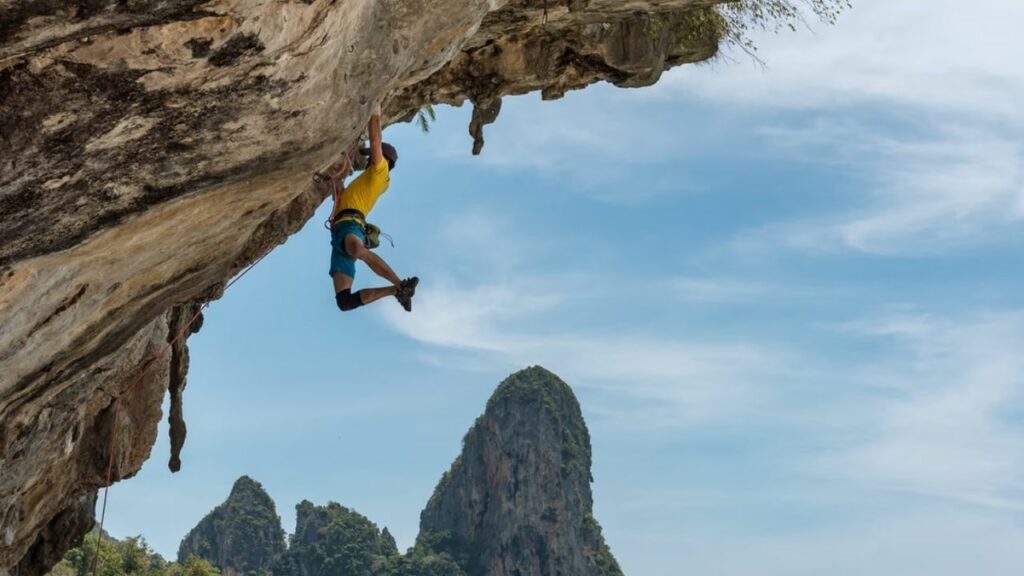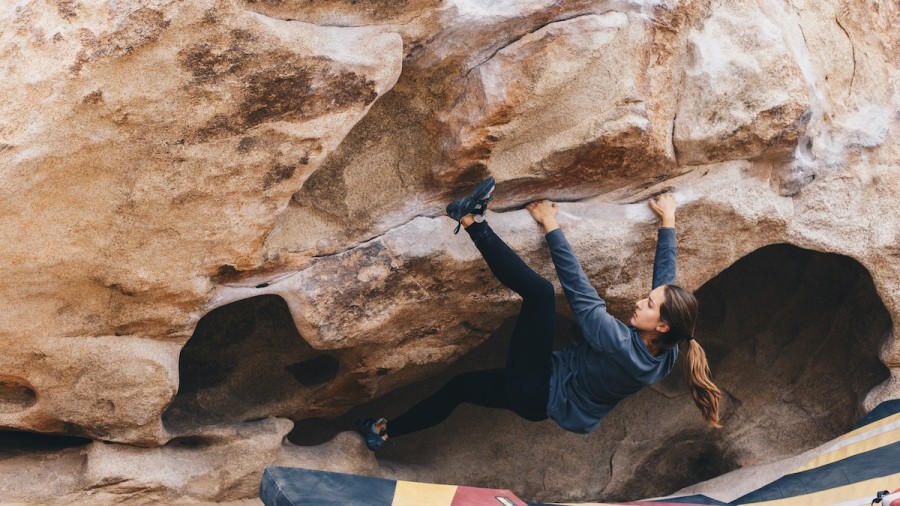Are you ready to take your climbing skills to new heights? Whether you’re a beginner or an experienced climber, understanding how to progress in climbing grades can be super beneficial.
Climbing is as thrill-seeking as it can get. But how do we measure our progress and set goals? That’s where climbing grades come into play.
Two commonly used grading systems are the Yosemite Decimal System (YDS) and the French grading system. In this guide, I’ll discuss YDS because we’re talking about the US for the most part.
It’s a numerical scale that ranges from 5.0 to 5.15. The scale starts with the easiest climbs at 5.0 and progresses in difficulty as the number increases. Decimal points (e.g., 5.8, 5.10) refine each number’s difficulty.
Now that you know the basics, let’s talk about the real question: How long does it take to progress? And how to do it faster and more efficiently?
On average, beginners may take 4-5 months to learn the fundamentals and get better at climbing before moving on to the intermediate section. Subsequently, the advanced climbing grades should take about 6 months to a year. After which, it solely depends on your talent and efforts.
Here’s a table based on my experience and some data I collected:
| Climbing Level | Time to Advance to Next Grade | Grades |
| Beginner | Several months to a year | 5.0 – 5.6 |
| Novice | 6 months to 1 year | 5.7 – 5.9 |
| Intermediate | 1-2 years | 5.10a – 5.10d |
| Advanced | 2-4 years | 5.11a – 5.12c |
| Expert | 3-6 years | 5.12d – 5.13c |
| Elite | 5+ years | 5.13d – 5.15 |
From my two decades of experience, I have 7 tips for you. And if you follow them, you’ll be able to breeze through beginner, novice, and intermediate grades quickly.
Tip #1 Don’t be afraid and stay consistent.
Fear is a natural part of climbing, especially when attempting more challenging routes. Here are some strategies to help you overcome fear:
- Visualize yourself successfully completing the climb and focus on positive outcomes.
- Start with climbs slightly outside your comfort zone and progressively push your boundaries.
- Replace negative thoughts with positive affirmations. I know it’s cringy, but it works!
Consistency is key to progress in climbing grades. Regular practice allows you to develop muscle memory, refine techniques, and build strength.
The best way to stay consistent is by establishing a consistent climbing schedule that aligns with your lifestyle. And finding ways to make climbing fun and engaging for you.

Tip #2 Building a Strong Foundation
Mastering proper body positioning is crucial for efficient climbing. Maintain a balanced and centered body position to distribute weight effectively on the holds and maintain stability.
When training, focus on engaging your core muscles to maintain control. A strong core will also help with body tension and balance.
Secondly, focus on precise foot placements and using your feet to support your weight. Proper footwork helps you conserve energy.
As for your upper body, learn different handholds, such as crimps, slopers, and pockets. Develop finger strength through exercises like hangboarding. And work on learning both open-hand and closed-hand grip techniques.
Tip #3 Training for Progression
To continue advancing in climbing grades, structured training programs and exercises can help you improve your climbing abilities.
A. Strength Training
Upper Body: Focus on exercises that target your upper body, such as pull-ups, push-ups, and shoulder presses.
Core: Include exercises such as planks, Russian twists, and hanging leg raises. A strong core provides stability and helps transfer power between your upper and lower body.
Lower Body: Squats, lunges, and calf raises can improve leg strength, stability, and balance.
B. Finger Strength Exercises
Climbing places significant demands on your finger strength. Incorporate finger strength exercises to improve your ability to grip holds and hang on for longer periods. You can consider practicing hangboarding, campus boarding, and finger rolls.
C. Endurance Training
Endurance training helps improve your stamina and ability to sustain climbing movements over a longer period.
Circuit Training: Set up a series of climbing routes or problems with minimal rest in between. Aim to complete the circuit without extended breaks, focusing on maintaining consistent movement.
Interval Training: Alternate between high-intensity climbing intervals and periods of active rest.
ARC Training: ARC (Aerobic Restoration and Capillarity) training involves sustained, low-intensity climbing for an extended period. The goal is to increase blood flow and improve endurance.

Tip #4 Mental Preparedness and Technique Refinement
While physical strength and technical skills are important in climbing, mental preparedness, and refined techniques are equally crucial.
Problem-Solving Skills: Climbing often requires problem-solving on the go. Train your mind to think critically and adapt to changing situations. Analyze routes, plan your moves, and be open to alternative solutions.
Movement Efficiency: Focus on efficient movement techniques to conserve energy and improve climbing performance. Work on smooth transitions between holds, precise footwork, and utilizing momentum effectively.
Body Awareness: Pay attention to body positioning, weight distribution, and finding optimal body angles for different climbing situations.
Technique Workshops: Consider attending technique-focused workshops or clinics to refine your climbing skills.
Tip #5 Climbing Progression Strategies
Progressing through climbing grades requires a systematic approach and a focus on setting achievable goals. Let’s break down the process for you.
Setting Realistic Goals: Identify your long-term objectives in climbing and break them down into smaller milestones for a more manageable progression. These short-term goals must align with your current abilities and the grades you aim to achieve.
Gradual Progression: Gradually increase the difficulty of climbs within your target grade range. Pushing your limits incrementally allows for skill development while minimizing the risk of injury.
Varying Styles: Explore different climbing styles, such as bouldering, sport climbing, or trad climbing, to broaden your skill set and experience diverse challenges.
Seeking Guidance: Consider taking lessons or hiring a climbing coach if you need it. Otherwise, connect with experienced climbers who can guide, advise, and support you throughout your climbing journey.
Tip #6 Safety and Injury Prevention
Prioritizing safety might as well equal untethered growth when it comes to climbing. Because even a minor injury can set you back several weeks or months, not to mention disrupt your life.
Equipment: Always use reliable climbing equipment, including harnesses, ropes, carabiners, and helmets. Regularly inspect your gear for any signs of wear and tear, and replace it as needed.
Partner Check: Before each climb, perform a partner check to ensure that your climbing partner’s gear is properly secured.
Injury Prevention: Actively try to prevent injuries with warm-ups and cool-downs. Additionally, allow your body ample rest and recovery time between climbing sessions.
Listen to Your Body: If you experience persistent pain or suspect an injury, consult a medical professional for evaluation and appropriate treatment.
Tip #7 Celebrating Progress and Enjoying the Journey
Throughout your climbing journey, don’t forget to celebrate your progress and find joy in the process.
Milestone Celebrations: Celebrate reaching significant milestones, such as completing a challenging route or progressing to a higher grade.
Community Support: Engage with fellow climbers, celebrate their successes, and draw inspiration from their stories.
Remember, climbing is not solely about reaching higher grades; it’s about personal growth, self-discovery, and love for the sport. Enjoy the process, stay motivated, and celebrate the small victories along the way.

Frequently Asked Questions (FAQs)
1. Can I skip climbing grades?
While it’s possible to occasionally skip a grade, it’s generally recommended to progress gradually to ensure you have a strong foundation of skills and techniques. Rushing through grades without mastering the necessary fundamentals may increase the risk of injuries and limit long-term progress.
2. Are cross-training and strength training important for climbing progression?
Cross-training and strength training is beneficial for climbing. Incorporating exercises that target core strength, finger strength, and overall body conditioning can enhance your climbing abilities.
3. What should I do if I feel stuck at a certain climbing grade?
Plateaus are common in climbing. If you feel stuck at a certain grade, consider seeking advice from experienced climbers or instructors who can provide personalized guidance. The best way to get over a slump is by working hard and grinding harder.
4. How can I track my progress in climbing?
Tracking your progress is crucial for goal setting and motivation. Keep a climbing journal or log where you record the climbs you complete, their grades, and any notable achievements or challenges. Monitor your performance, analyze areas for improvement, and compare your progress over time.
5. Can I progress in climbing grades without outdoor climbing experience?
While outdoors can be valuable for some, it’s possible to progress in climbing grades through indoor climbing only. Indoor climbing gyms offer a controlled environment to practice techniques, build strength, and work on specific climbing movements.
6. What is a hard problem in climbing?
On average, a hard problem may take 10 to 50 attempts or even more to conquer. This can span multiple climbing sessions, where you return to the problem multiple times to work on specific sequences, refine your technique, and build strength and endurance.

